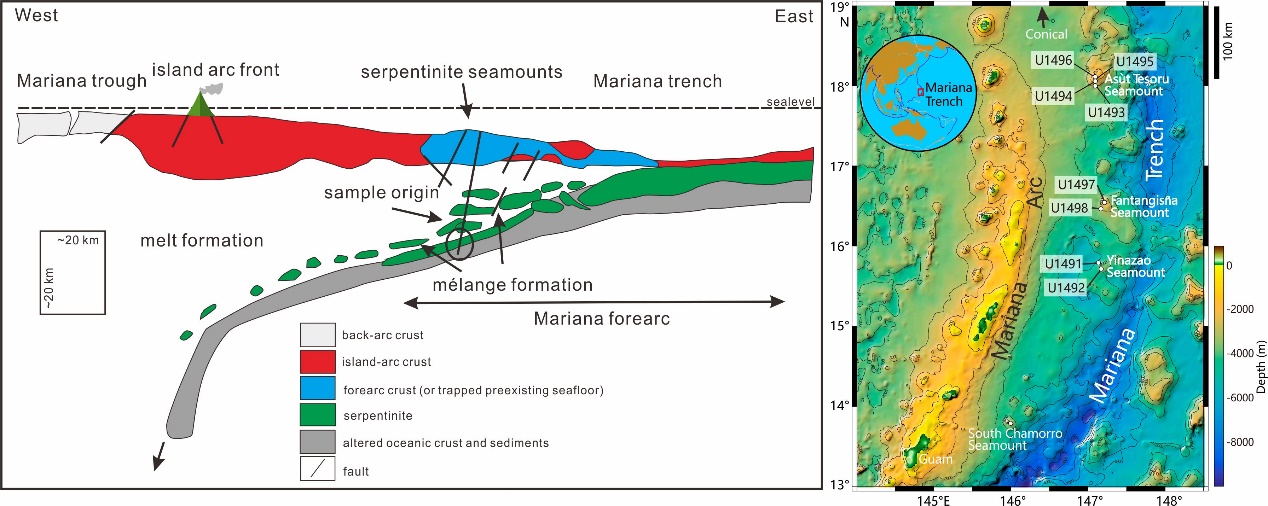Subduction zones have a crucial role in mediating global element cycling and maintaining the Earth's geochemical mass balances. Fluid pathways may also exist within the forearc, which may play an important role in the element cycling and geochemical mass balance at subduction zones.
A series of active serpentinite mud volcanoes were formed in the eastern half of the Mariana forearc region, the metabasite clasts recovered from these volcanoes represent fragments of the subducting Pacific slab that were incorporated into overlying forearc faults as gouge and exhumed via serpentinite mud volcanism. Therefore, such rocks can provide direct ways to study the element and isotope fractionation during the subduction metamorphism at an active convergent margin.
Recently, the research team led by Prof. SUN Weidong from the Institute of Oceanology of the Chinese Academy of Sciences (IOCAS) published a combined study of petrography, mineral chemistry, and B isotopes in the metabasite rocks recovered from Fantangisna and Asut Tesoru Seamounts during the recent International Ocean Discovery Program (IODP) Expedition 366. The main objectives are to reveal the processes of dehydration and fluid-rock interactions in the Mariana forearc zone and to contribute to an overall understanding of the B cycle in the shallow subduction zone.
The study was published in Lithos on May 13.
Reaserchers found that the metabasites from Fantangisna and Asut Tesoru Seamounts consist mainly of low-temperature alteration minerals, corresponding to zeolite- to prehnite-pumpellyite-facies metamorphism. The metamorphic minerals are enriched in fluid mobile elements (e.g., B, As, Sb, Pb), thus fixing the B concentrations of the subducted oceanic crust during shallow subduction (<18 km). The metabasites have high B concentrations and heavier B isotopic compositions than their mid-ocean ridge basalts (MORB) and ocean island basalts (OIB) protoliths.
"In addition, from Fantangisna through Asut Tesoru to South Chamorro Seamounts, the δ11B values of the metabasites generally show a decreasing trend, which was most likely caused by prograde metamorphic dehydration," said LIU Haiyang, first author of the study.
The dehydration modeling results suggest that gradual prograde metamorphism dehydration can generally account for the B isotopic signatures of Mariana arc lavas. Fluids released from sediments of the subducted slab beneath the forearc are characterized by lower δ11B values.
Thus, the forearc mantle is an important filter for B systematics across-strike in subduction zones, one that results in an overall heavy B signature in Mariana arc lavas. However, the different B isotope compositions of two groups of Mariana arc lavas are largely controlled by the variable sediment/altered oceanic crust (AOC) ratios caused by the subduction of Magellan seamounts.
This study was financially supported by the National Natural Science Foundation of China, Strategic Priority Research Program (B) of the Chinese Academy of Sciences, the China Postdoctoral Science Foundation, the postdoctoral innovation project of Shandong province, etc.

Mariana forearc zone. Schematic plot illustrating the cross section of typical settings for serpentinite mud volcanoes in Mariana forearc.

Distributions of (a) B (μg/g) and (b) δ11B values of the metabasites recovered from the Fantangisna, Asut Tesoru and South Chamorro Seamounts, organized in order of increasing distance to the trench axis (i.e., increasing pressure and temperature conditions).
Liu Haiyang., Xue Ying.-Yu., Yang Tinggen., Jin Xin., You Chen.-Feng., Lin Chiou.-Ting., Sun Wei.-Dong. and Deng Jianghong. (2022). Fluid-rock interactions at shallow depths in subduction zone: Insights from trace elements and B isotopic composition of metabasites from the Mariana forearc. Lithos, 422-423, 106730.
LIU Haiyang
Institute of Oceanology
E-mail: hyliu@qdio.ac.cn
(Editor: ZHANG Yiyi)
|
|

Address: 7 Nanhai Road, Qingdao, Shandong 266071, China
Tel: 86-532-82898902 Fax: 86-532-82898612 E-mail: iocas@qdio.ac.cn


